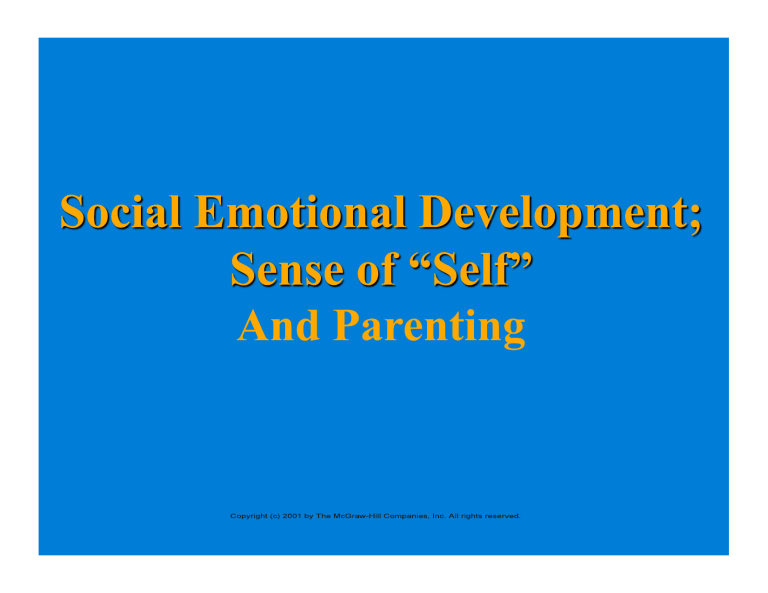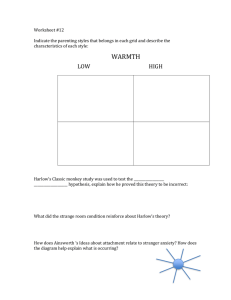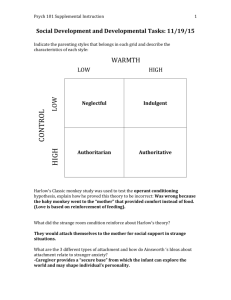Document 11140938

Sense of Self
• Mirror recognition – 18 months (Brooks-
Gunn)
– By age 2
• Use of “I,” “me,” “mine”
• Physical characteristics
– By age 8
• Social identity
• Personality trait terms
• Social comparison
Sense of Self
• Categorical/Physical in preschool years
• In childhood sense of self based on many factors – increasing use of comparison to others
• Becomes increasingly complex and abstract through adolescence
Sense of Self: Stages and Processes
• Development of Self
– Joint attention – 9 mo
– Self-recognition - 15-24 mo
– Categorical self – 18-24 mo
– Based on
• Cognitive development
• Social experience
Identity Development
• Erikson
– Identity vs. Role Confusion
– Adolescence
• Identity crisis
• Moratorium
• Adulthood – Intimacy Versus Isolation go back
Attachment Theory
• Emphasis on the close emotional ties to an adult caregiver
• Based on theories of Lorenz, Harlow, and the work of Rene Spitz on Orphaned
Children
Attachment in Humans: Proposed
Mechanisms
• Caregiver-Infant Relationships
– Early contact not crucial nor sufficient
– Neonatal reflexes endearing to parent, e.g., smiling
– Cooing and babbling
• Early conversations
– Synchronized routines
• Peek-A-Boo
• Sensitive responding
Imprinting
Definition of Imprinting
•
The rapid, innate learning within a limited critical period of time that involves attachment to the first moving object seen
Attachment in Humans: Proposed
Stages
• Infant-Caregiver Relationships
– Social responsiveness
• Birth: Undiscriminating
• 2-6 mo: Preferences
– Proximity seeking
• 6 mo – 3 yrs
• Attachment figures
– Partnerships by 3 yrs
Strange Situation Procedure
• SSP – lab task used to measure the ‘quality of attachment.
• Secure vs. Anxiously attached.
• http://www.psychology.sunysb.edu/ attachment/
Caregiving Styles and
Attachment Classification
• Caregivers of securely attached babies are sensitive to their signals - consistently available to respond to their infants’ needs.
• Caregivers of avoidant babies - unavailable or rejecting
• Caregivers of resistant babies sometimes respond to their babies’ need and sometimes do not.
• Caregivers of disorganized babies often neglect or physically abuse their babies.
Issues In Attachment Theory
• Naturally occurring Fears– Separation
Anxiety; Stranger Wariness
• Adult as a “Secure Base”
• Quality of Attachment Predicts later
Developmental Outcomes
• Quality of Parental “responsiveness” predicts quality of attachment
Attachment: Outcomes
– Securely attached child
• Cognitively and socially competent
• Expect positive reactions
– Insecurely attached child
• Withdrawn, dependent, fearful
• Less competent
– Patterns last through adolescence
Temperament Theory
• Temperament: Inborn traits that organize how the child responds to his or her world.
• May form the basis for later personality
– Genetically based
– Buss & Plomin
• Emotionality, Activity, Sociability (EAS)
– Kagan: Behavioral Inhibition –shyness
– Thomas & Chess
• Easy, Difficult, Slow to warm-up
– Goodness of Fit
Dimensions of Temperament
(Thomas & Chess)
• Activity level
• Rhythmicity
• Approach-withdrawal
• Adaptability
• Intensity of reaction
• Threshold of responsiveness
• Quality of mood
• Distractibility
• Attention span
Classification of Parenting Styles
Types of Child Discipline-
Disciplinary Strategies
• Power Assertion: Using physical punishment or a show of force
• Withdrawal of Love: Withholding affection
• Management Techniques: Stress Inductive
Strategies. Use a combination of praise, recognition, approval, rules and reasoning
Baumrind’s Parenting Styles
• Authoritative
• Authoritarian
• Permissive
• Neglecting Rejecting
Dimensions of parenting
• Control/Demand Characteristics
• Warmth/Affection/Child Centeredness
• Predominant Disciplinary Strategies
Figure 15.2
Child Outcomes and Parenting
Styles: Authoritarian Families
• Tend to perform moderately well in school
• Typically uninvolved in problem behavior.
• Poorer social skills, lower self-esteem, and higher levels of depression.
Child Outcomes: Permissive
Families
• Children more likely to be involved in problem behavior
• Tend to perform less well in school.
• Higher self-esteem, better social skills, and lower levels of depression.
Authoritative Parenting: Child
Outcomes
• More socially and instrumentally competent
• They are more likely to do well in school
• Less likely to dropout or get involved in the drug scene.
• Positive indictors of emotion regulation
Uninvolved/Rejecting-Neglecting
• Children and adolescents whose parents are uninvolved perform most poorly in all domains



